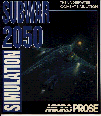
Weapon systems have reached a frightening level of sophistication in Subwar 2050. While torpedoes are still in use they seem to require a great deal more sonar skill. For an active torpedo to hit a hostile target the sonar computer has to return a firing solution greater than 100 per cent. In Subwar 2050 combat is engaged at ridiculously close distances due to the difficulty involved in detecting a "stealthed" submarine. The atmosphere is very like "a knife-fight in a telephone booth", especially when two or more subs are launching short range rockets (SUBROCs) at each other. Those genteel days of long range wire guided Mark 48 torpedoes are well and truly over. The very last word in SUBROC technology would have to be the dreaded Particle Beam Rocket System. An energy beam is fired, blasting a conduit through the water. This is now the pathway for an armor-piercing rocket launched "down the pipe" at Mach 2. Suffice it to say, the only real defence against the PBRS seems to involve getting your best shots in first.
Subwar 2050 is bound to be a direct hit with avowed flight-sim and naval warfare buffs alike. The graphics are very tasty; actual seafloor topography has been texture-mapped in 3D for each scenario and all objects are scaleable, filled-polygon renderings. There are five campaign scenarios, playable at three levels of difficulty: Training, Antarctica, North Atlantic, South China Sea and Sea of Japan. While its soundscape is admirable for combat effects, the game suffers from an uninspired musical score. For a real sense of "depth" I can recommend playing Subwar 2050 as it should be; accompanied by soundtracks of The Abyss and The Hunt for Red October... After all, what could be more appropriate?
Reviewed on: PC 386 SX-33, Sound Blaster Pro audio card.
Recommended retail price: $99.95. Suggested audience rating: PD (Parental Discretion) Overall score: 90%Software supplied by: Sega-Ozisoft Pty. Ltd.